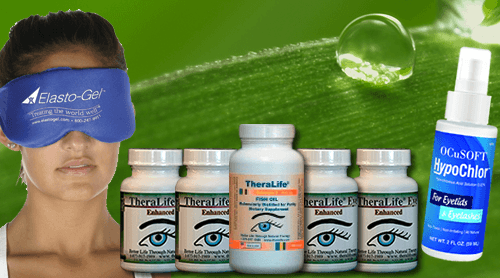Why TheraLife Works – Natural Dry Eye Relief
TheraLife® goes right to the source of the problem. Our all-natural supplements for chronic dry eye relief address the fundamental cause of painful, inflamed and dry eyes: underactive tear secretion. Only TheraLife® targets this issue intra-cellularly to restore balance and end the cycle of dry, itchy red eyes. TheraLife® promotes your own cellular functioning, in order to provide natural dry eye relief with your own body’s healing tears. After treatment with TheraLife®, you will once again have a natural ability to make tears, eliminating inflammation and dryness. End your reliance on eye drops and restore your own comfortable vision. Whether you suffer from watery dry eyes, blepharitis, mebomian gland dysfunction, chronic and severe dry eyes, or Sjogren’s dry eye/dry mouth symptoms, TheraLife® can end pain and help you get your life back. Don’t waste time with treatments that don’t work or that fail to address the root cause of your problem. Get TheraLife® today!
References – Oral Dry Eye Relief
- 1.Latkany R. Dry eyes: etiology and management. Curr Opin Ophthalmol. 2008;19:287–91. doi: 10.1097/ICU.0b013e3283023d4c. [DOI] [PubMed] [Google Scholar]
- 2.Fox RI, Stern M, Michelson P. Update in Sjögren’s syndrome. Curr Opin Rheumatol. 2000;12:391–8. doi: 10.1097/00002281-200009000-00007. [DOI] [PubMed] [Google Scholar]
- 3.DEW. The definition and classification of dry eye disease: report of the Definition and Classification Subcommittee of the International Dry Eye Workshop. Ocul Surf. 2007;5:75–92. doi: 10.1016/s1542-0124(12)70081-2. [DOI] [PubMed] [Google Scholar]
- 4.Luo L, Li DQ, Doshi A, et al. Experimental dry eye stimulates production of inflammatory cytokines and MMP-9 and activates MAPK signaling pathways on the ocular surface. Invest Ophthalmol Vis Sci. 2004;4:4293–301. doi: 10.1167/iovs.03-1145. [DOI] [PubMed] [Google Scholar]
- 5.Acera A, Rocha G, Vecino E, et al. Inflammatory markers in the tears of patients with ocular surface disease. Ophthalmic Res. 2008;40:315–21. doi: 10.1159/000150445. [DOI] [PubMed] [Google Scholar]
- 6.Pflugfelder SC, Farley W, Luo L, et al. Matrix metalloproteinase-9 knockout confers resistance to corneal epithelial barrier disruption in experimental dry eye. Am J Pathol. 2005;166:61–71. doi: 10.1016/S0002-9440(10)62232-8. [DOI] [PMC free article] [PubMed] [Google Scholar]
- 7.Yoon KC, De Paiva CS, Qi H, et al. Expression of Th-1 chemokines and chemokine receptors on the ocular surface of C57BL/6 mice: effects of desiccating stress. Invest Ophthalmol Vis Sci. 2007;48:2561–9. doi: 10.1167/iovs.07-0002. [DOI] [PubMed] [Google Scholar]
- 8.Tsubota K, Fukagawa K, Fujihara T, et al. Regulation of human leukocyte antigen expression in human conjunctival epithelium. Invest Ophthalmol Vis Sci. 1999;40:28–34. [PubMed] [Google Scholar]
- 9.Pisella PJ, Brignole F, Debbasch C, et al. Flow cytometric analysis of conjunctival epithelium in ocular rosacea and keratoconjunctivitis sicca. Ophthalmology. 2000;107:1841–9. doi: 10.1016/s0161-6420(00)00347-x. [DOI] [PubMed] [Google Scholar]
- 10.de Paiva CS, Pflugfelder SC. Rationale for anti-inflammatory therapy in dry eye syndrome. Arq Bras Oftalmol. 2008;71:89–95. doi: 10.1590/s0004-27492008000700017. [DOI] [PubMed] [Google Scholar]
- 11.Peral A, Domínguez-Godínez CO, Carracedo G, Pintor J. Therapeutic targets in dry eye syndrome. Drug News Perspect. 2008;21:166–76. [PubMed] [Google Scholar]
- 12.Donnenfeld E, Pflugfelder SC. Topical ophthalmic cyclosporine: pharmacology and clinical uses. Surv Ophthalmol. 2009;54:321–38. doi: 10.1016/j.survophthal.2009.02.002. [DOI] [PubMed] [Google Scholar]
- 13.Pintor J, Peral A, Hoyle CH, et al. Effects of diadenosine polyphosphates on tear secretion in New Zealand white rabbits. J Pharmacol Exp Ther. 2002;300:291–7. doi: 10.1124/jpet.300.1.291. [DOI] [PubMed] [Google Scholar]
- 14.Tauber J, Davitt WF, Bokosky JE, et al. Double-masked, placebo-controlled safety and efficacy trial of diquafosol tetrasodium (INS365) ophthalmic solution for the treatment of dry eye. Cornea. 2004;23:784–92. doi: 10.1097/01.ico.0000133993.14768.a9. [DOI] [PubMed] [Google Scholar]
- 15.Stiles GL. Adenosine receptors and beyond: molecular mechanisms of physiological regulation. Clin Res. 1990;38:10–8. [PubMed] [Google Scholar]
- 16.Baharav E, Bar-Yehuda S, Madi L, et al. Antiinflammatory effect of A3 adenosine receptor agonists in murine autoimmune arthritis models. J Rheumatol. 2005;32:469–76. [PubMed] [Google Scholar]
- 17.Fishman P, Bar-Yehuda S, Madi L, et al. The PI3K–NF-κ B signal transduction pathway is involved in mediating the anti-inflammatory effect of IB-MECA in adjuvant-induced arthritis. Arthritis Research &Therapy. 2006;8:1–9. doi: 10.1186/ar1887. [DOI] [PMC free article] [PubMed] [Google Scholar]
- 18.Rath-Wolfson L, Bar Yehuda S, Madi L, et al. IB-MECA, an A3 adenosine receptor agonist prevents bone resorption in rats with adjuvant induced arthritis. Clin & Exp Rheum. 2006;24:400–6. [PubMed] [Google Scholar]
- 19.Bar-Yehuda S, Silverman MH, Kerns WD, et al. The anti-inflammatory effect of A3 adenosine receptor agonists: a novel targeted therapy for rheumatoid arthritis. Expert Opin Inves Drugs. 2007;16:1601–13. doi: 10.1517/13543784.16.10.1601. [DOI] [PubMed] [Google Scholar]
- 20.Mabley J, Soriano F, Pacher P, et al. The adenosine A3 receptor agonist, N6-(3-iodobenzyl)-adenosine-5’-N-methyluronamide, is protective in two murine models of colitis. Eur J Pharmacol. 2003;466:323–9. doi: 10.1016/s0014-2999(03)01570-x. [DOI] [PubMed] [Google Scholar]
- 21.Bar Yehuda S, Rat-Wolfson L, Del Valle L, et al. CF101 induces anti-inflammatory effect and prevents cartilage damage in rat knee osteoarthritis. Arthritis & Rheumatol accepted. 2009 doi: 10.1002/art.24817. [DOI] [PubMed] [Google Scholar]
- 22.Lee HT, Kim M, Joo JD, et al. A3 adenosine receptor activation decreases mortality and renal and hepatic injury in murine septic peritonitis. Am J Physiol Regul Integr Comp Physiol. 2006;291:R959–69. doi: 10.1152/ajpregu.00034.2006. [DOI] [PubMed] [Google Scholar]
- 23.van Troostenburg AR, Clark EV, Carey WDH, et al. Tolerability, pharmacokinetics, and concentration-dependent hemodynamic effects of oral CF101, an A3 adenosine receptor agonist, in healthy young men. Int J Clin Pharmacol Ther. 2004;42:534–42. doi: 10.5414/cpp42534. [DOI] [PubMed] [Google Scholar]
- 24.Silverman MH, Strand V, Markovits D, et al. Clinical evidence for utilization of the A3 adenosine receptor as a target to treat rheumatoid arthritis: data from a phase II clinical trial. Rheumatol. 2008;35:41–8. [PubMed] [Google Scholar]
- 25.Schiffman RM, Christianson MD, Jacobsen G, et al. Reliability and validity of the Ocular Surface Disease Index. Arch Ophthalmol. 2000;118:615–21. doi: 10.1001/archopht.118.5.615. [DOI] [PubMed] [Google Scholar]
- 26.Cohen IJ. Use of fluorescein in the eye. J Occup Med. 1963;5:540–1. [PubMed] [Google Scholar]
- 27.Holland MC. Fluorescein staining of the cornea. JAMA. 1964;188:81. doi: 10.1001/jama.1964.03060270087025. [DOI] [PubMed] [Google Scholar]
- 28.Kellerman D, Rossi Mospan A, Engels J, et al. Denufosol: a review of studies with inhaled P2Y2 agonists that led to Phase 3. Pulm Pharmacol Ther. 2008;21:600–7. doi: 10.1016/j.pupt.2007.12.003. [DOI] [PubMed] [Google Scholar]
- 29.Carré DA, Mitchell CH, Peterson-Yantorno K, et al. Similarity of A3-adenosine and swelling-activated Cl(-) channels in nonpigmented ciliary epithelial cells. Am J Physiol Cell Physiol. 2000;279:C440–51. doi: 10.1152/ajpcell.2000.279.2.C440. [DOI] [PubMed] [Google Scholar]
- 30.Yang H, Avila MY, Peterson-Yantorno K, et al. The cross-species A3 adenosine-receptor antagonist MRS 1292 inhibits adenosine-triggered human nonpigmented ciliary epithelial cell fluid release and reduces mouse intraocular pressure. Curr Eye Res. 2005;30:747–54. doi: 10.1080/02713680590953147. [DOI] [PMC free article] [PubMed] [Google Scholar]



